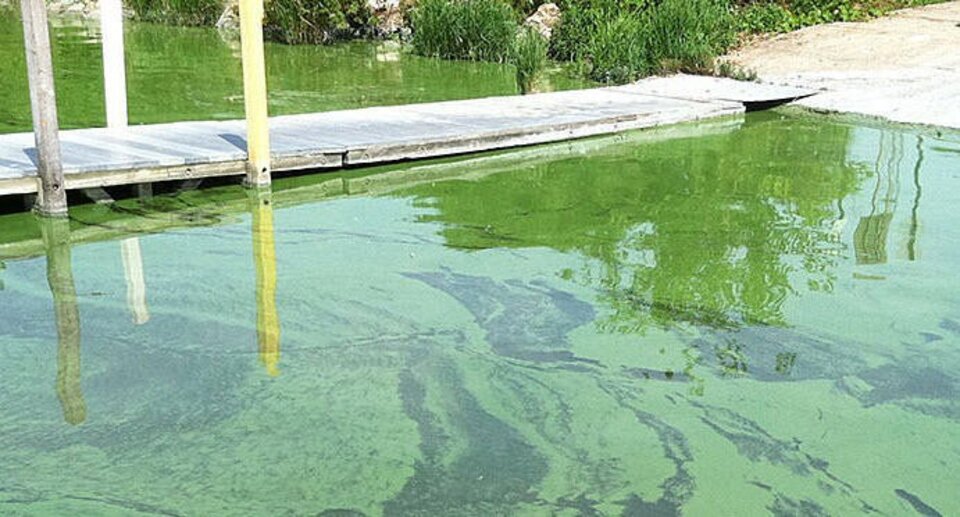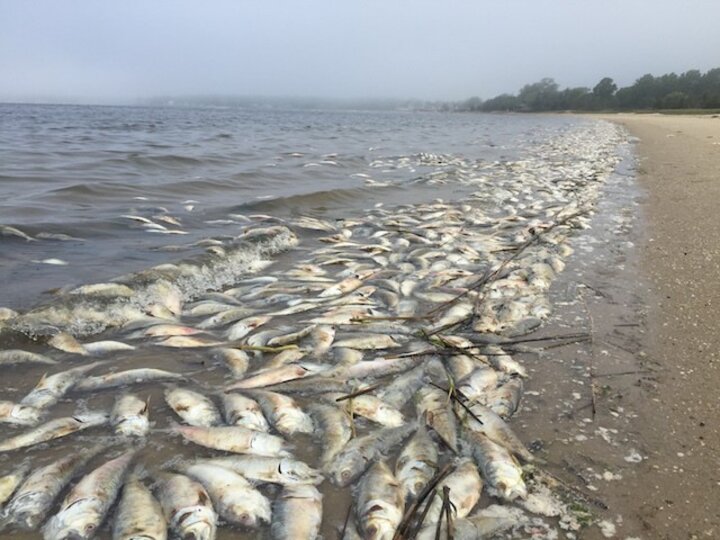Effects of Manure on Fish Populations

Author: Anthony Meusch
Algal blooms may occur in bodies of water with excess amounts of nitrogen and phosphorus. These algal blooms are detrimental to fish populations, other animal populations, and possibly human health.
This article is written by a University of Nebraska-Lincoln student, Anthony Meusch, as part of an Animal Manure Management class in Biological Systems Engineering. It has been reviewed by experts to encourage accuracy of issues presented. The article represents the student’s understanding of the subject addressed at this stage in his career. Rick Koelsch, faculty instructor.Manure is an important resource produced in livestock agriculture. When applied to crops in the correct amount, nitrogen and phosphorus are utilized by the crops and not lost into the environment. Manure also can affect the environment in negative ways. Nitrogen, specifically, contains a risk of runoff or leaching through the soil if manure is stored or applied incorrectly and eventually finds its way into the water supply. Phosphorus moves with soil erosion and runoff to surface waters.
What kills the fish?
A process called eutrophication occurs when the excess nutrients enter the water supply. Algal blooms occurs when the algae grows at large rates by utilizing the excess nutrients. The algae will then die followed by the death of fish; the dense growth of algae will create a lack of oxygen in the water. According to an August 25, 2017 article “Poor manure practices culprit in thousands of fish deaths” by the Toledo Blade more than 66,000 fish deaths were estimated along four sites near Lake Erie in the month of August 2017 alone. Officials did in fact determine poor manure management to be the cause of such deaths.

Sunlight penetrating the water will also be reduced by the algal bloom. In addition to oxygen deprivation, algal blooms present health risks. According to a February 21, 2018 article by Penn State University entitled “Agriculture and the Environment” which states, “Blue-green algae or cyanobacteria can release toxins that can sicken or kill people and animals.” Results of the 2017 Toledo discharges impacted over 500,000 people as they were advised to not use their water because the bacteria made it unsafe to consume.
Why use manure anyway?
Crops require major nutrients such as nitrogen, phosphorus, and potassium. When manure is applied to crops, it becomes an organic fertilizer. Many times neighboring fields will utilize the manure. The use of an organic fertilizer compared to an inorganic fertilizer has its advantages and disadvantages. Advantages of organic fertilizers would be saving money by not purchasing mineral fertilizers that are mined, improvements to soil health resulting from the organic matter in the manure, and using the manure that would otherwise be a waste on site. A disadvantage of organic fertilizers would be the application rate of manure to meet one crop nutrient requirement, often nitrogen, can deliver excess phosphorus and potassium for meeting a crop’s fertility needs. Repeat annual applications to the same field will increase risk of phosphorus runoff causing algal blooms. Applications scheduled every 2 to 5 years to the same field can minimize the water quality risk and deliver the benefits of manure.
Manure is not strictly bad for fish. In many cases, poultry or cattle manure is fed to fish farms. Application of manure to aquaculture has been done in the eastern countries for many years. According to the Food and Agriculture Organization website, fertilizers are applied to fish farms, “to increase the production of natural food organisms” which are mainly plankton. Supplementing the manure for other feed can decrease the overall price and increase yields. However, excess nutrients can be an important trigger to the algal blooms discussed earlier.
Managing the problem
How do we prevent algal blooms? The biggest takeaway from this issue is the importance of managing manure and applying manure correctly. Nutrient discharges are possible from:
- Poorly managed manure storages or animal housing, or
- Field receiving nutrients at rates greater than what the crop requires, or
- Field with significant erosion or runoff.
Here in Nebraska, the Nebraska Department of Environment and Energy (NDEE) requires an inspection of nearly all animal feeding operations (small, medium, and large). If the inspections determine a permit is needed, the farming operation is considered a concentrated animal feeding operation (CAFO) and has to submit data and other information to the NDEE each year. All discharges of manure into the waters supply must be reported; these discharges must be handled swiftly. The NDEE monitors the permitted CAFOs in the state, but issues arise when the animal feeding operations that are not monitored are unknowingly discharging nutrients into the water supply.
Recommendations
- If an animal feeding operation does not have a permit, it is recommended that an inspection be requested by the NDEE.
- Discharges from manure storage or manure handling should always be reported to the NDEE .
- Understanding the application rate of manure in relation to crop requirements is also important. A nutrient management plan will determine the manure nutrients produced and desired application rates. This plan will help to find the best application rate of manure compared to the amount of nutrients needed by the crops.
References and Additional Reading Options
Chislock, M. F., Doster, E., Zitomer, R. A. & Wilson, A. E. (2013) Eutrophication: Causes, Consequences, and Controls in Aquatic Ecosystems. Nature Education Knowledge 4(4):10. Retrieved October 28, 2018, from https://www.nature.com/scitable/knowledge/library/eutrophication-causes- consequences-and-controls-in-aquatic-102364466
FERTILIZING FISH PONDS. (n.d.). Retrieved October 28, 2018, from http://www.fao.org/fishery/static/FAO_Training/FAO_Training/General/x6709e/x6709e 06.htm
Jewell, S. (2018, February 21). Manure and Algal Blooms. Retrieved October 28, 2018, from https://sites.psu.edu/skj5242civicissues/2018/02/21/manure-and-algal-blooms/
Manure management and effects of manure on the environment. (n.d.). Retrieved October 28, 2018, from http://www.fao.org/WAIRDOCS/LEAD/X6113E/x6113e05.htm
Poor manure practices culprit in thousands of fish deaths. (2017, August 25). Retrieved October 28, 2018, from https://www.toledoblade.com/State/2017/08/24/Poor-manure-practices-culprit-in.html?abnpageversion=evoke
Livestock Waste Control Regulations. (2011, October 4). Retrieved October 28, 2018, from http://deq.ne.gov/RuleAndR.nsf/Title_130.xsp
Marine Researcher: 'Mahogany Tide' Algae Causing Fish Kill. RiverheadLOCAL, 3 June 2015, http://riverheadlocal.com/2015/05/30/marine-research-scientist-mahogany-tide-algal-bloom- caused-fish-kill-in-peconic-estuary/?nabw=1&nabr=10
Join Michigan Radio for Issues & Ale – Seeing Green in Lake Erie. RSS, 31 July 2018, http://www.michiganradio.org/term/toxic-algae-blooms
This article was reviewed by Tiffany Messer and Aaron Mittelstet, faculty in UNL Biological Systems Engineering